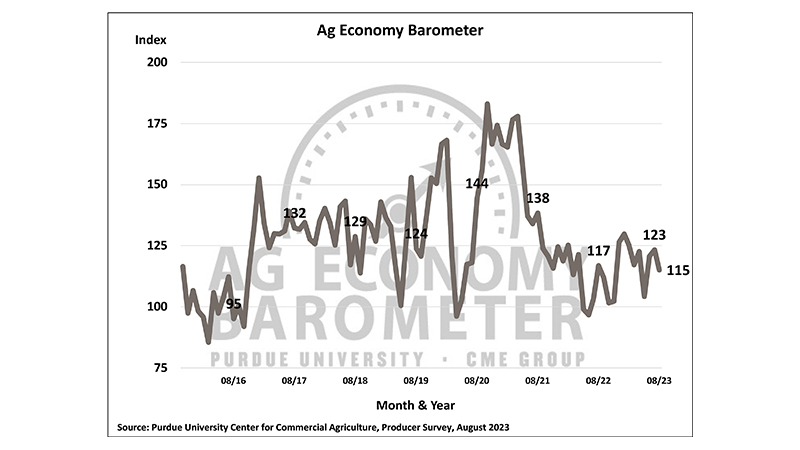Producer sentiment was notably lower in August, as the Purdue University/CME Group Ag Economy Barometer index dipped 8 points to a reading of 115. This month’s decline was fueled by producers’ weaker perception of current conditions both on their farms and in U.S. agriculture. The Index of Current Conditions fell 13 points to a reading of 108. The Index of Future Expectations also declined 5 points in August to a reading of 119. This month’s Ag Economy Barometer survey was conducted from August 14-18.
“Rising interest rates and concerns about high input prices continue to put downward pressure on producer sentiment,” said James Mintert, the barometer’s principal investigator and director of Purdue University’s Center for Commercial Agriculture. “This month over half (60%) of the producers we surveyed said they expect interest rates to rise in the upcoming year.”
When asked about their top concerns for their farming operations in the next 12 months, producers continue to point to higher input prices (34% of respondents) and rising interest rates (24% of respondents). Even though crop prices weakened significantly this summer, only one in five producers (20% of respondents) chose declining commodity prices as one of their top concerns.
The Farm Capital Investment Index was lower this month, falling 8 points to a reading of 37. Increasing prices for farm machinery and new construction along with rising interest rates continue to be the two most commonly cited reasons for their negative view. Meanwhile, producers’ rating of farm financial conditions changed little in August, as the Farm Financial Conditions Index declined just one point to a reading of 86.
Despite increasing concerns about rising interest rates, producers remain cautiously optimistic about farmland values. The Short-Term Farmland Value Expectations Index rose one point to 126, while the long-term index was unchanged at a reading of 151. About 4 out of 10 (39%) respondents said they expect farmland values to rise over the next year, while 13% said they look for values to decline in the next year. When asked about their longer-term view of farmland values, more than 6 out of 10 (63%) respondents said they expect values to rise over the next five years, while 12% said they expect values to fall.
To better understand the usage of carbon contracts in row-crop agriculture, corn and soybean growers were asked about the types of conversations they have had with those companies. In the August survey, 6% of corn and soybean growers said they have engaged in discussions with companies about receiving payments to capture carbon on their farms, while just 2% said they had signed a carbon contract. Nearly half (47%) of the farms who discussed contract terms with a company said they were offered a payment rate of $10 to $20 per metric ton of carbon captured. Among the farms who engaged in discussions but chose not to sign a carbon contract, half said it was because the payment level was too low.
Read the full Ag Economy Barometer report at https://purdue.ag/agbarometer. The site also offers additional resources—such as past reports, charts and survey methodology—and a form to sign up for monthly barometer email updates and webinars.
Each month, the Purdue Center for Commercial Agriculture provides a short video analysis of the barometer results, available at https://purdue.ag/barometervideo. For more information, check out the Purdue Commercial AgCast podcast available at https://purdue.ag/agcast, which includes a detailed breakdown of each month’s barometer and a discussion of recent agricultural news that affects farmers.



